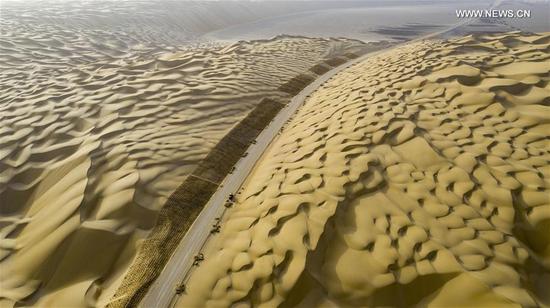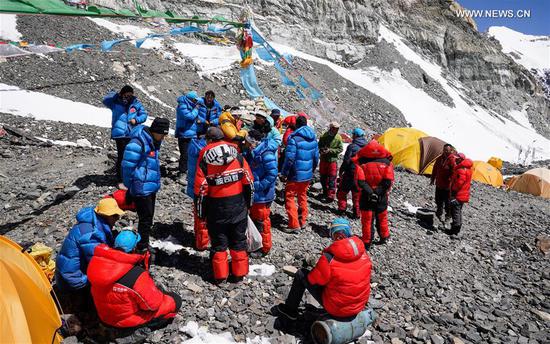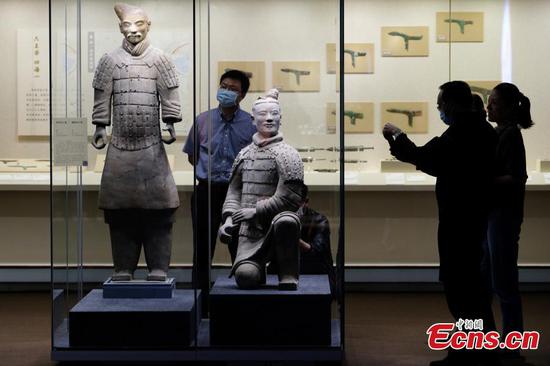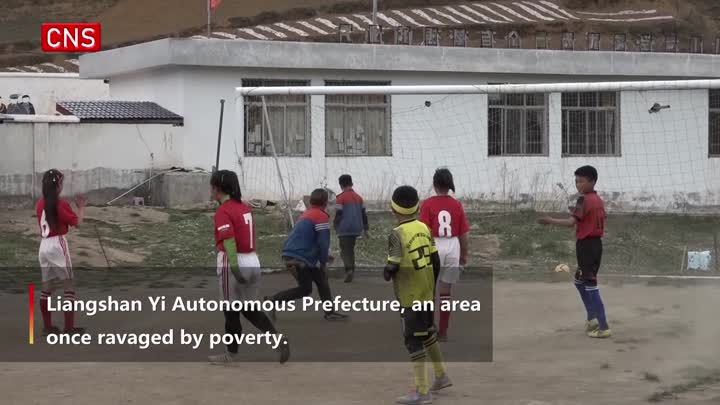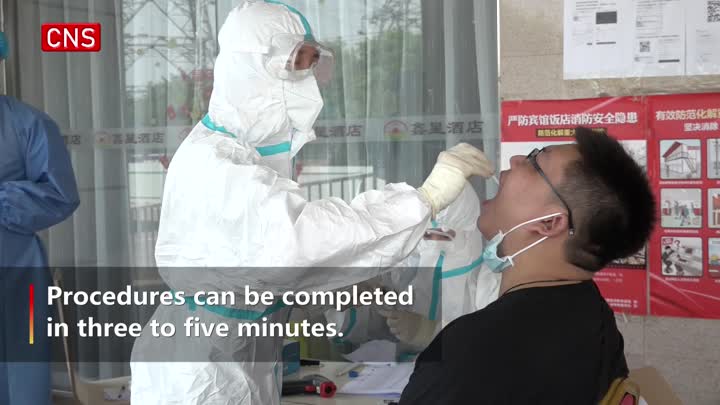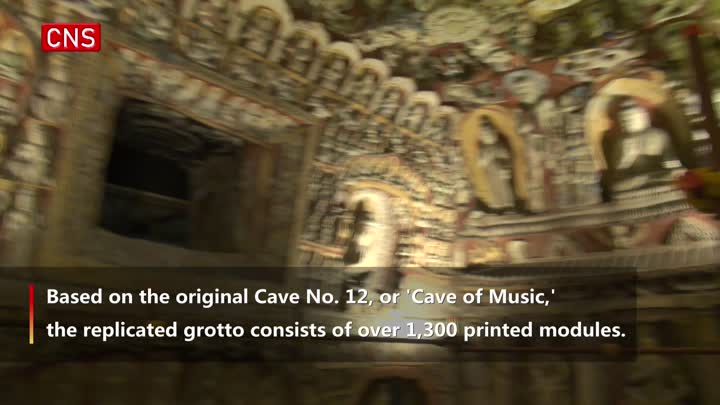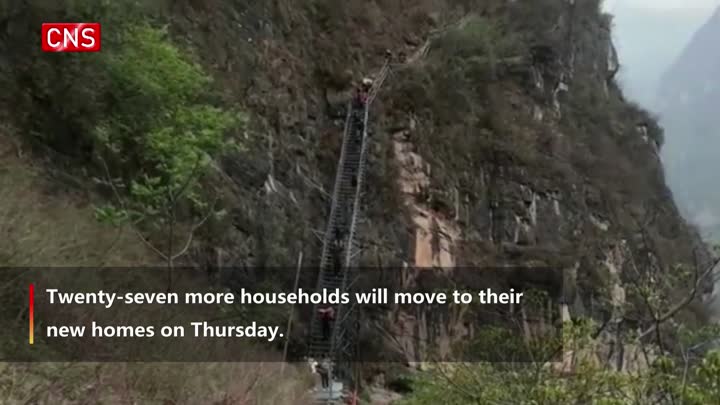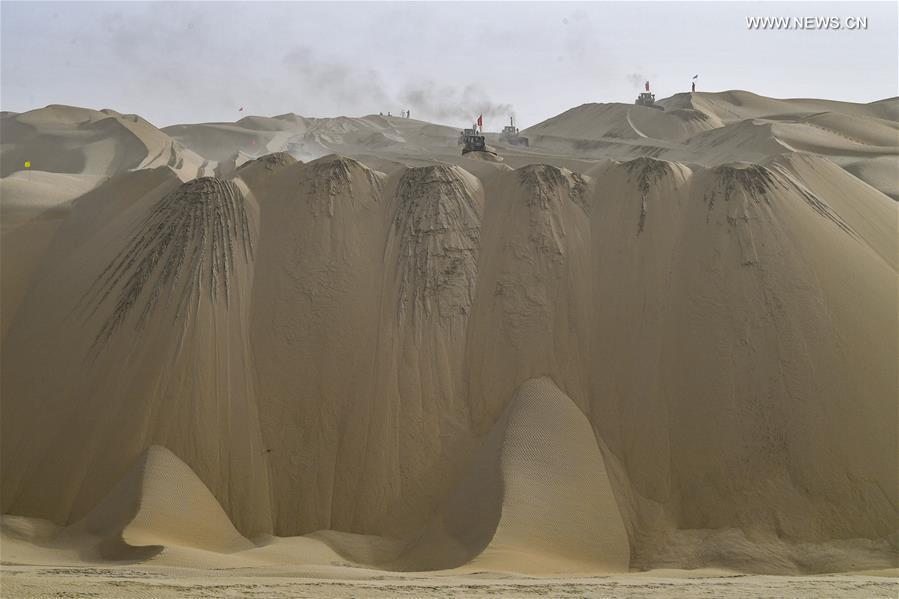
Workers drive bulldozers at the construction site of a highway in Taklimakan Desert, northwest China's Xinjiang Uygur Autonomous Region, May 16, 2020. The construction of Yuli-Qiemo highway, the third north-south route running through Taklimakan Desert, has entered the final rush. Workers of China Communications Construction Company Ltd. are working on the largest dune in this project, with an estimated volume of 1.2 million cubic meters of sand to deal with. They established camps next to the dune for the convenience of work, and receive daily necessities on a regular basis. The completion of the highway is expected to improve the transport conditions in southern Xinjiang and promote local development. (Xinhua/Hu Huhu)
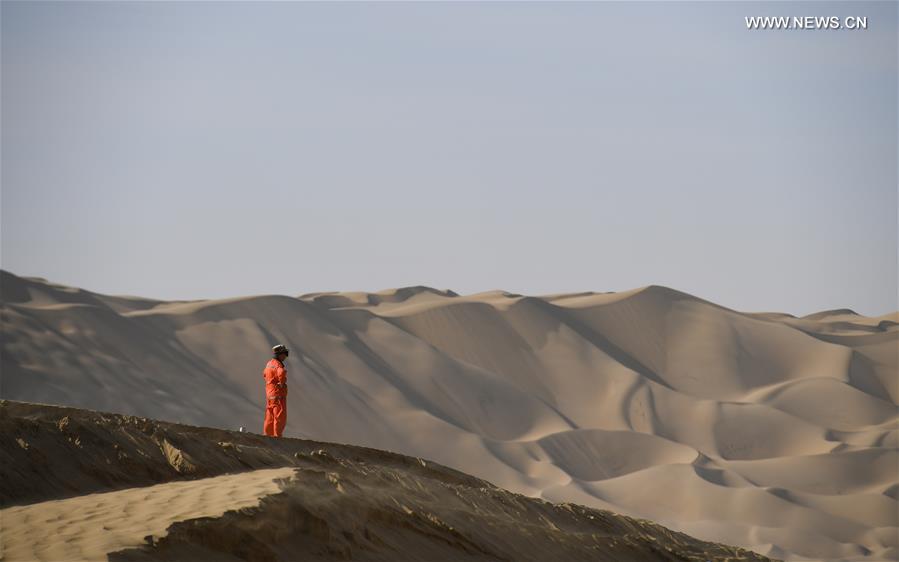
Worker Li Mingyou observes on a dune at the construction site of a highway in Taklimakan Desert, northwest China's Xinjiang Uygur Autonomous Region, May 16, 2020. The construction of Yuli-Qiemo highway, the third north-south route running through Taklimakan Desert, has entered the final rush. Workers of China Communications Construction Company Ltd. are working on the largest dune in this project, with an estimated volume of 1.2 million cubic meters of sand to deal with. They established camps next to the dune for the convenience of work, and receive daily necessities on a regular basis. The completion of the highway is expected to improve the transport conditions in southern Xinjiang and promote local development. (Xinhua/Song Yanhua)
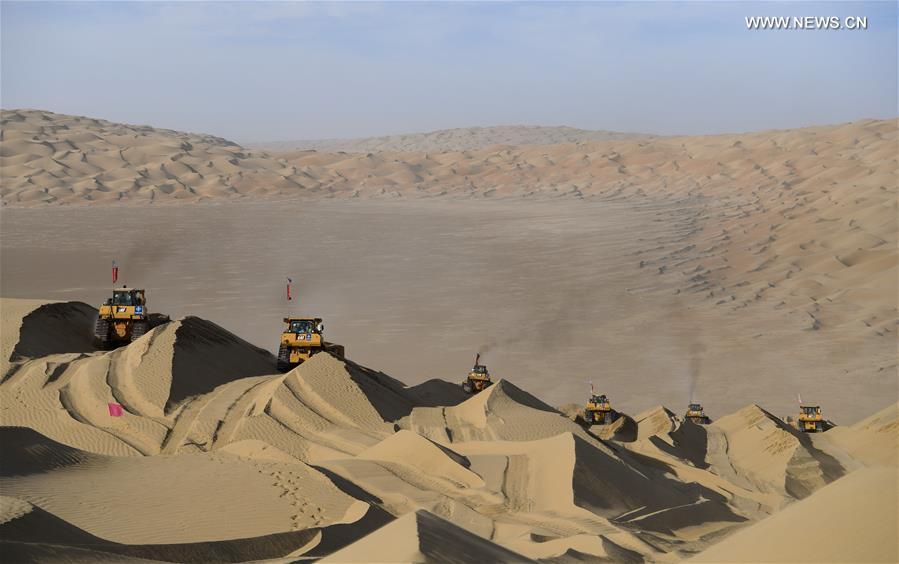
Workers drive bulldozers at the construction site of a highway in Taklimakan Desert, northwest China's Xinjiang Uygur Autonomous Region, May 16, 2020. The construction of Yuli-Qiemo highway, the third north-south route running through Taklimakan Desert, has entered the final rush. Workers of China Communications Construction Company Ltd. are working on the largest dune in this project, with an estimated volume of 1.2 million cubic meters of sand to deal with. They established camps next to the dune for the convenience of work, and receive daily necessities on a regular basis. The completion of the highway is expected to improve the transport conditions in southern Xinjiang and promote local development. (Xinhua/Song Yanhua)
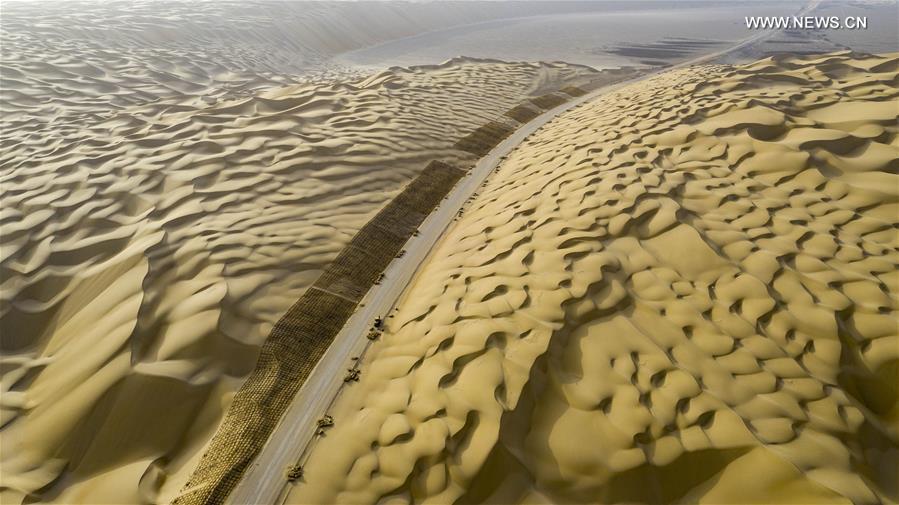
Aerial photo taken on May 17, 2020 shows a highway under construction in Taklimakan Desert, northwest China's Xinjiang Uygur Autonomous Region. The construction of Yuli-Qiemo highway, the third north-south route running through Taklimakan Desert, has entered the final rush. Workers of China Communications Construction Company Ltd. are working on the largest dune in this project, with an estimated volume of 1.2 million cubic meters of sand to deal with. They established camps next to the dune for the convenience of work, and receive daily necessities on a regular basis. The completion of the highway is expected to improve the transport conditions in southern Xinjiang and promote local development. (Xinhua/Hu Huhu)
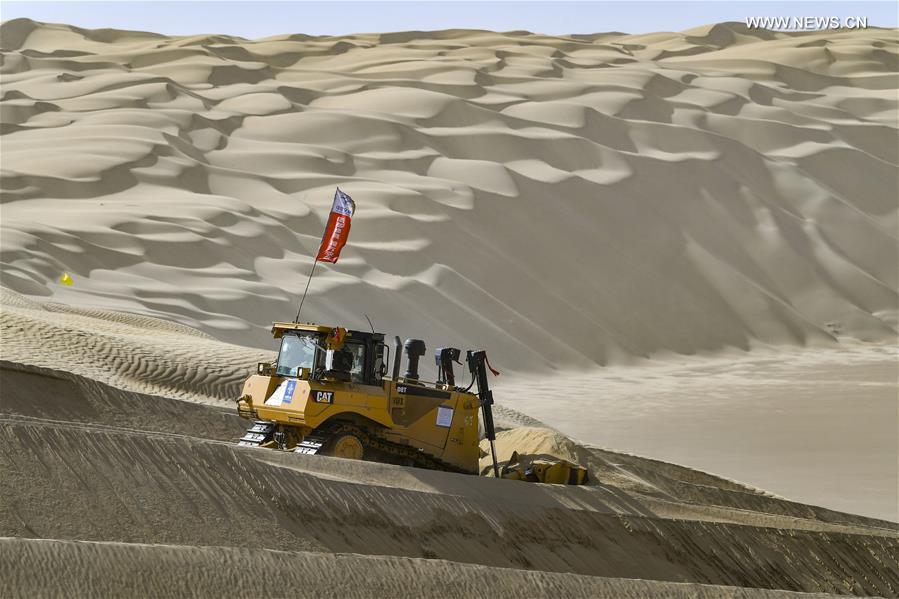
A worker drives a bulldozer at the construction site of a highway in Taklimakan Desert, northwest China's Xinjiang Uygur Autonomous Region, May 16, 2020. The construction of Yuli-Qiemo highway, the third north-south route running through Taklimakan Desert, has entered the final rush. Workers of China Communications Construction Company Ltd. are working on the largest dune in this project, with an estimated volume of 1.2 million cubic meters of sand to deal with. They established camps next to the dune for the convenience of work, and receive daily necessities on a regular basis. The completion of the highway is expected to improve the transport conditions in southern Xinjiang and promote local development. (Xinhua/Hu Huhu)
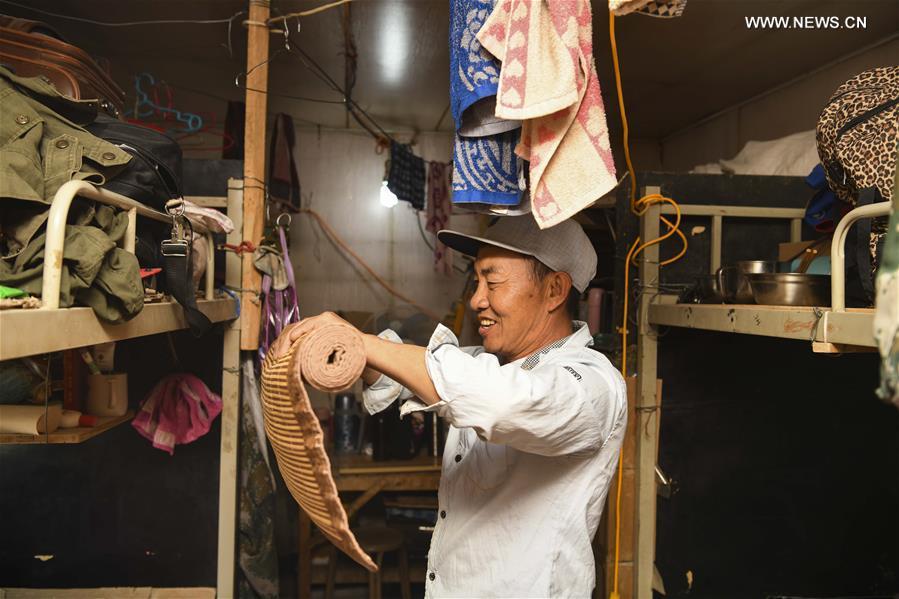
Worker Ouyang Lin arranges a mat at a camp of the construction site of a highway in Taklimakan Desert, northwest China's Xinjiang Uygur Autonomous Region, May 16, 2020. The construction of Yuli-Qiemo highway, the third north-south route running through Taklimakan Desert, has entered the final rush. Workers of China Communications Construction Company Ltd. are working on the largest dune in this project, with an estimated volume of 1.2 million cubic meters of sand to deal with. They established camps next to the dune for the convenience of work, and receive daily necessities on a regular basis. The completion of the highway is expected to improve the transport conditions in southern Xinjiang and promote local development. (Xinhua/Hu Huhu)
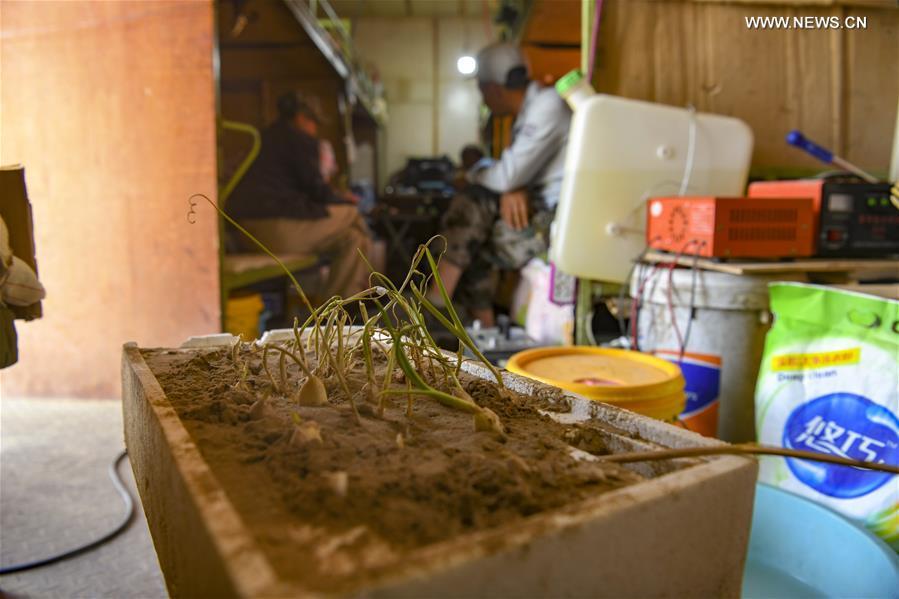
Photo taken on May 16, 2020 shows garlic bolts developed by workers at a construction camp in Taklimakan Desert, northwest China's Xinjiang Uygur Autonomous Region. The construction of Yuli-Qiemo highway, the third north-south route running through Taklimakan Desert, has entered the final rush. Workers of China Communications Construction Company Ltd. are working on the largest dune in this project, with an estimated volume of 1.2 million cubic meters of sand to deal with. They established camps next to the dune for the convenience of work, and receive daily necessities on a regular basis. The completion of the highway is expected to improve the transport conditions in southern Xinjiang and promote local development. (Xinhua/Hu Huhu)
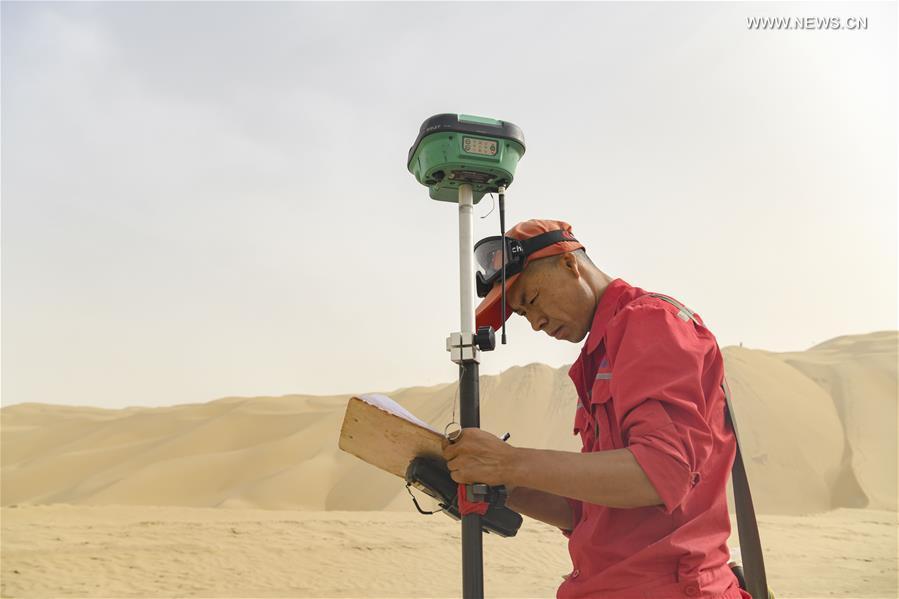
Surveyor Liu Yaojun works at the construction site of a highway in Taklimakan Desert, northwest China's Xinjiang Uygur Autonomous Region, May 17, 2020. The construction of Yuli-Qiemo highway, the third north-south route running through Taklimakan Desert, has entered the final rush. Workers of China Communications Construction Company Ltd. are working on the largest dune in this project, with an estimated volume of 1.2 million cubic meters of sand to deal with. They established camps next to the dune for the convenience of work, and receive daily necessities on a regular basis. The completion of the highway is expected to improve the transport conditions in southern Xinjiang and promote local development. (Xinhua/Hu Huhu)
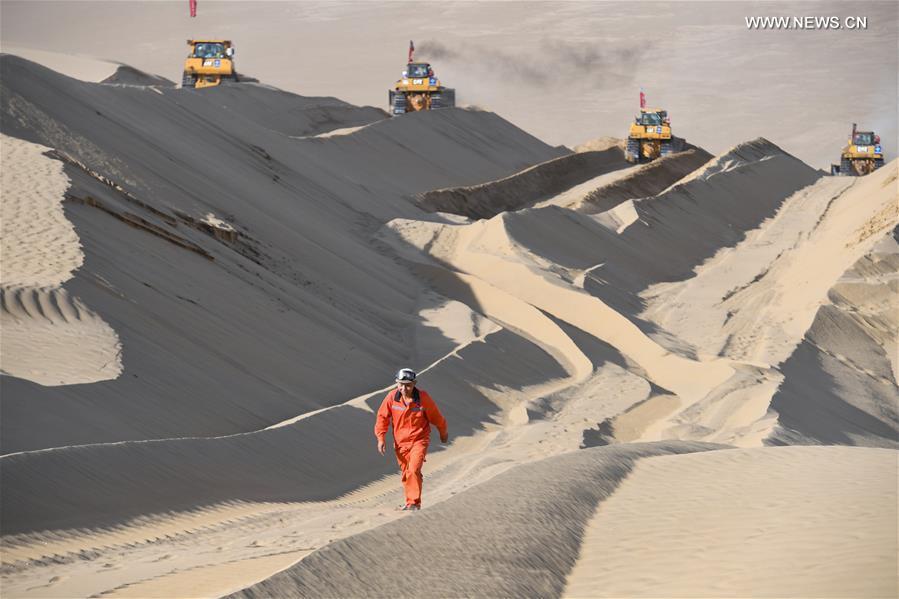
Worker Li Mingyou walks on a dune at the construction site of a highway in Taklimakan Desert, northwest China's Xinjiang Uygur Autonomous Region, May 16, 2020. The construction of Yuli-Qiemo highway, the third north-south route running through Taklimakan Desert, has entered the final rush. Workers of China Communications Construction Company Ltd. are working on the largest dune in this project, with an estimated volume of 1.2 million cubic meters of sand to deal with. They established camps next to the dune for the convenience of work, and receive daily necessities on a regular basis. The completion of the highway is expected to improve the transport conditions in southern Xinjiang and promote local development. (Xinhua/Song Yanhua)
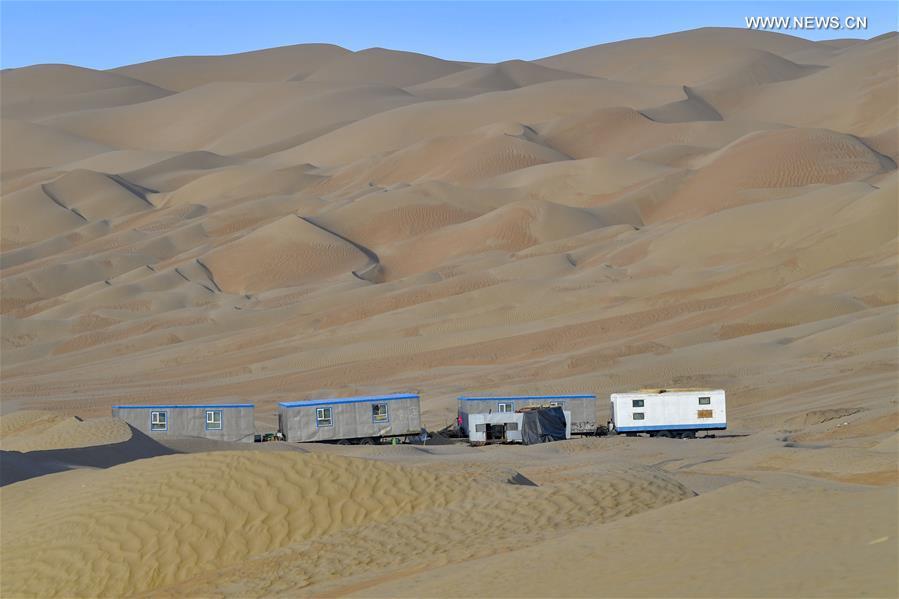
Photo taken on May 16, 2020 shows camps near the construction site of a highway in Taklimakan Desert, northwest China's Xinjiang Uygur Autonomous Region. The construction of Yuli-Qiemo highway, the third north-south route running through Taklimakan Desert, has entered the final rush. Workers of China Communications Construction Company Ltd. are working on the largest dune in this project, with an estimated volume of 1.2 million cubic meters of sand to deal with. They established camps next to the dune for the convenience of work, and receive daily necessities on a regular basis. The completion of the highway is expected to improve the transport conditions in southern Xinjiang and promote local development. (Xinhua/Hu Huhu)
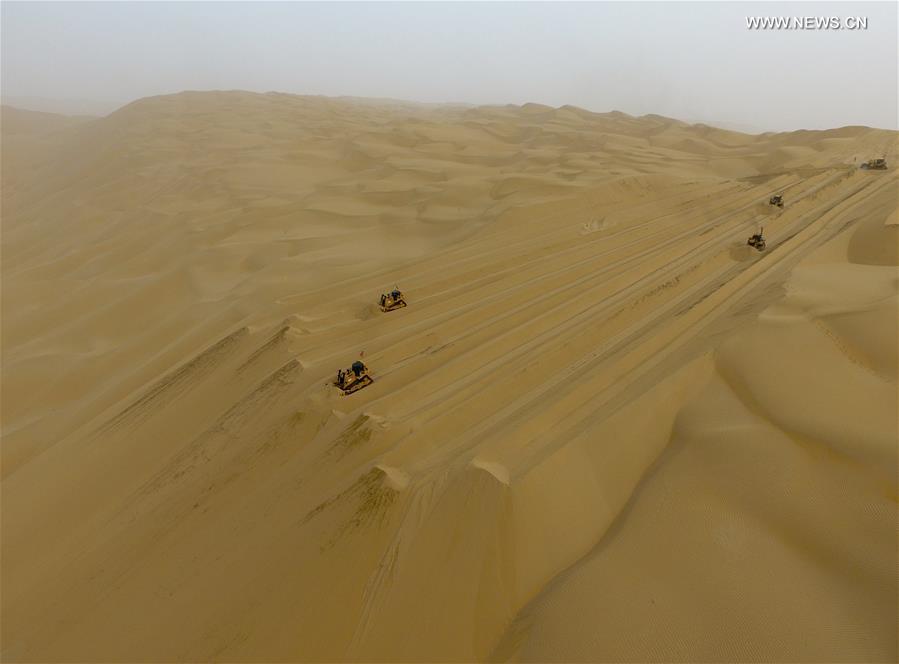
Workers drive bulldozers at the construction site of a highway in Taklimakan Desert, northwest China's Xinjiang Uygur Autonomous Region, May 16, 2020. The construction of Yuli-Qiemo highway, the third north-south route running through Taklimakan Desert, has entered the final rush. Workers of China Communications Construction Company Ltd. are working on the largest dune in this project, with an estimated volume of 1.2 million cubic meters of sand to deal with. They established camps next to the dune for the convenience of work, and receive daily necessities on a regular basis. The completion of the highway is expected to improve the transport conditions in southern Xinjiang and promote local development. (Xinhua/Song Yanhua)
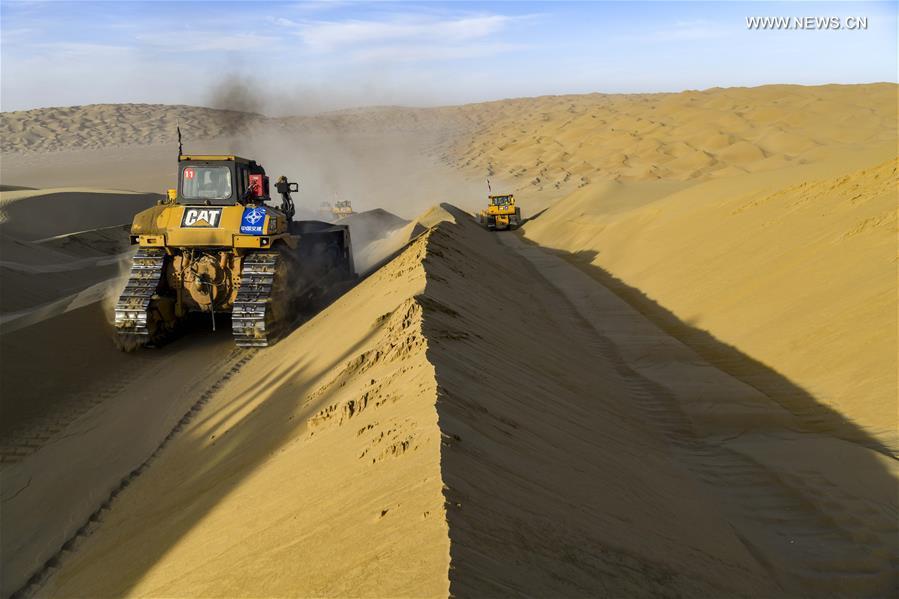
Workers drive bulldozers at the construction site of a highway in Taklimakan Desert, northwest China's Xinjiang Uygur Autonomous Region, May 16, 2020. The construction of Yuli-Qiemo highway, the third north-south route running through Taklimakan Desert, has entered the final rush. Workers of China Communications Construction Company Ltd. are working on the largest dune in this project, with an estimated volume of 1.2 million cubic meters of sand to deal with. They established camps next to the dune for the convenience of work, and receive daily necessities on a regular basis. The completion of the highway is expected to improve the transport conditions in southern Xinjiang and promote local development. (Xinhua/Hu Huhu)
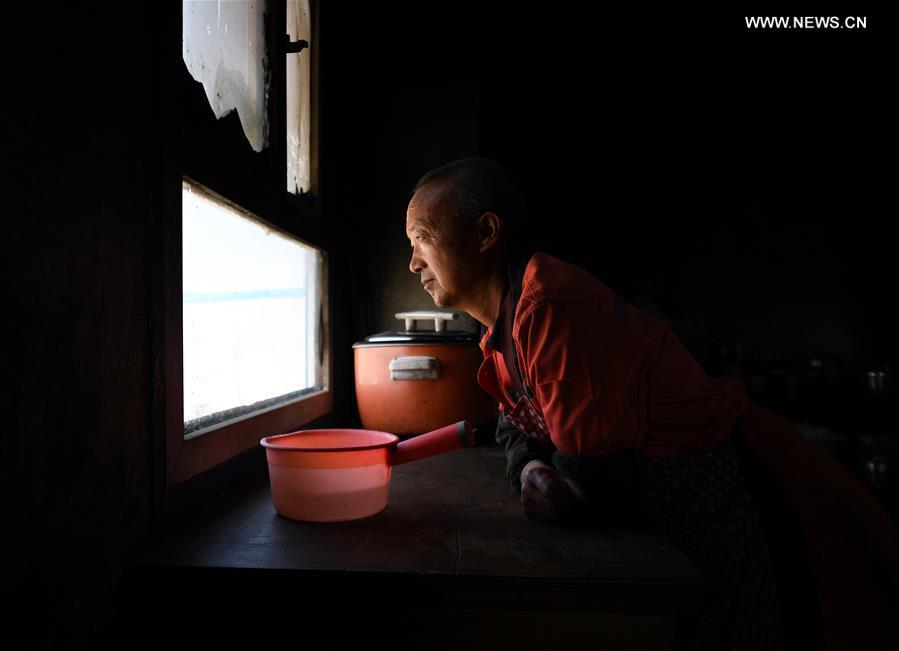
Chef Yang Yunming, 60, waits for his colleagues at a camp in Taklimakan Desert, northwest China's Xinjiang Uygur Autonomous Region, May 16, 2020. The construction of Yuli-Qiemo highway, the third north-south route running through Taklimakan Desert, has entered the final rush. Workers of China Communications Construction Company Ltd. are working on the largest dune in this project, with an estimated volume of 1.2 million cubic meters of sand to deal with. They established camps next to the dune for the convenience of work, and receive daily necessities on a regular basis. The completion of the highway is expected to improve the transport conditions in southern Xinjiang and promote local development. (Xinhua/Song Yanhua)
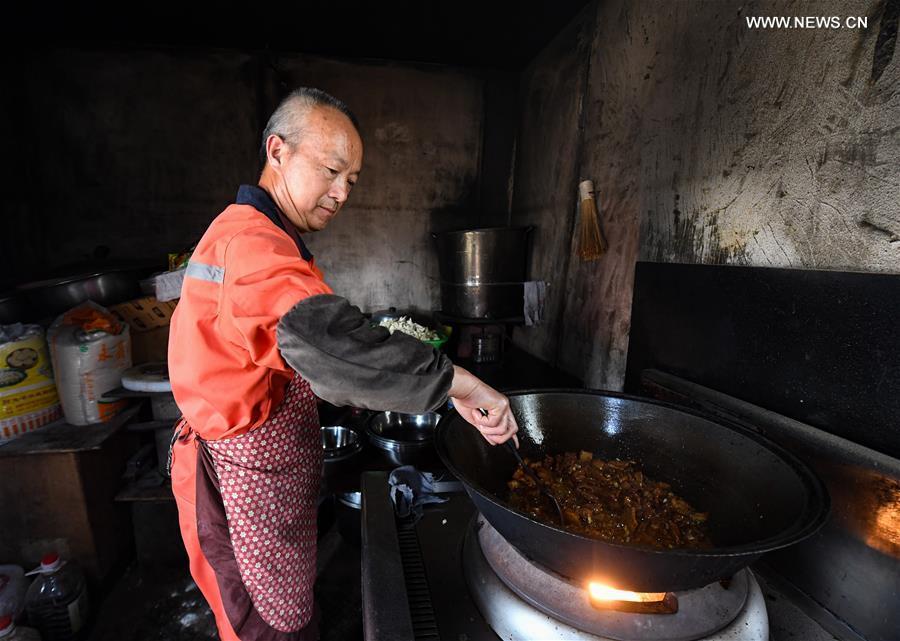
Chef Yang Yunming cooks at a camp of the construction site of a highway in Taklimakan Desert, northwest China's Xinjiang Uygur Autonomous Region, May 16, 2020. The construction of Yuli-Qiemo highway, the third north-south route running through Taklimakan Desert, has entered the final rush. Workers of China Communications Construction Company Ltd. are working on the largest dune in this project, with an estimated volume of 1.2 million cubic meters of sand to deal with. They established camps next to the dune for the convenience of work, and receive daily necessities on a regular basis. The completion of the highway is expected to improve the transport conditions in southern Xinjiang and promote local development. (Xinhua/Song Yanhua)
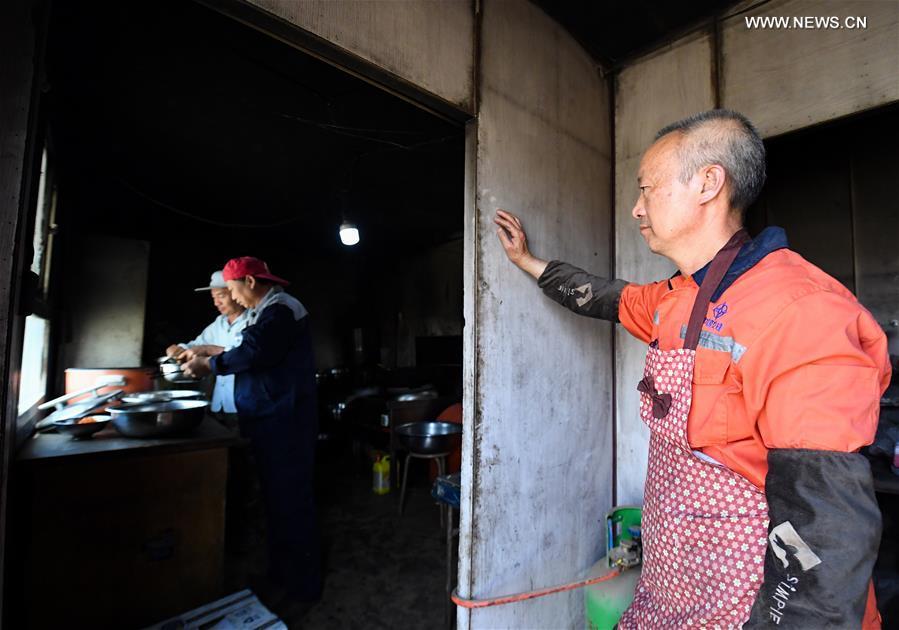
Chef Yang Yunming watches as his colleagues pick meals at a camp of the construction site of a highway in Taklimakan Desert, northwest China's Xinjiang Uygur Autonomous Region, May 16, 2020. The construction of Yuli-Qiemo highway, the third north-south route running through Taklimakan Desert, has entered the final rush. Workers of China Communications Construction Company Ltd. are working on the largest dune in this project, with an estimated volume of 1.2 million cubic meters of sand to deal with. They established camps next to the dune for the convenience of work, and receive daily necessities on a regular basis. The completion of the highway is expected to improve the transport conditions in southern Xinjiang and promote local development. (Xinhua/Song Yanhua)
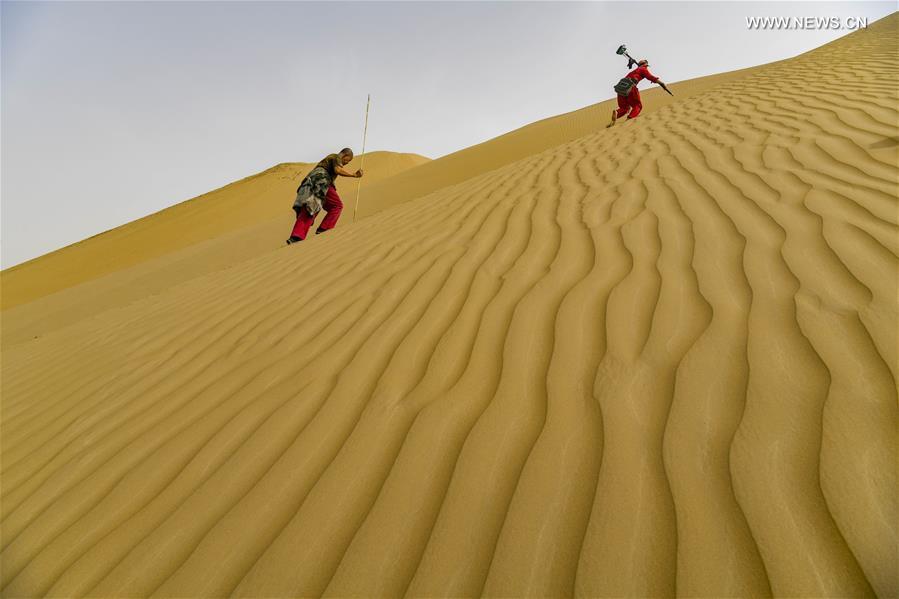
Surveyor Liu Yaojun (R) and his assistant Gan Caiyun walk on a dune at the construction site of a highway in Taklimakan Desert, northwest China's Xinjiang Uygur Autonomous Region, May 17, 2020. The construction of Yuli-Qiemo highway, the third north-south route running through Taklimakan Desert, has entered the final rush. Workers of China Communications Construction Company Ltd. are working on the largest dune in this project, with an estimated volume of 1.2 million cubic meters of sand to deal with. They established camps next to the dune for the convenience of work, and receive daily necessities on a regular basis. The completion of the highway is expected to improve the transport conditions in southern Xinjiang and promote local development. (Xinhua/Hu Huhu)
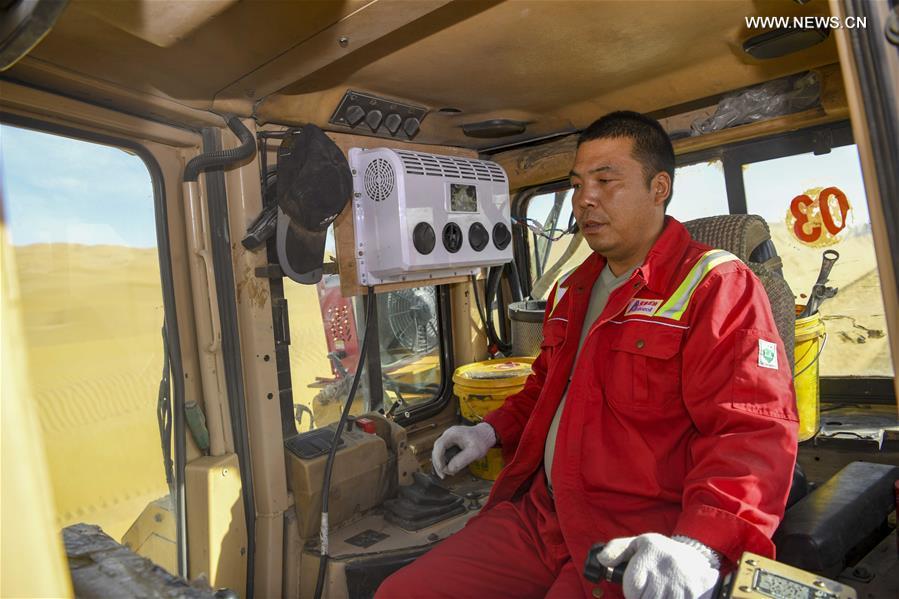
He Zhoumin, who participated in the construction of the second highway across Taklimakan Desert, drives a bulldozer at the construction site of a highway in Taklimakan Desert, northwest China's Xinjiang Uygur Autonomous Region, May 16, 2020. The construction of Yuli-Qiemo highway, the third north-south route running through Taklimakan Desert, has entered the final rush. Workers of China Communications Construction Company Ltd. are working on the largest dune in this project, with an estimated volume of 1.2 million cubic meters of sand to deal with. They established camps next to the dune for the convenience of work, and receive daily necessities on a regular basis. The completion of the highway is expected to improve the transport conditions in southern Xinjiang and promote local development. (Xinhua/Hu Huhu)

Aerial photo taken on May 16, 2020 shows a panoramic view of the construction site of a highway in Taklimakan Desert, northwest China's Xinjiang Uygur Autonomous Region. The construction of Yuli-Qiemo highway, the third north-south route running through Taklimakan Desert, has entered the final rush. Workers of China Communications Construction Company Ltd. are working on the largest dune in this project, with an estimated volume of 1.2 million cubic meters of sand to deal with. They established camps next to the dune for the convenience of work, and receive daily necessities on a regular basis. The completion of the highway is expected to improve the transport conditions in southern Xinjiang and promote local development. (Xinhua/Hu Huhu)

